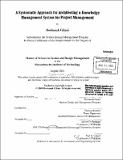| dc.contributor.advisor | Thomas Roemer. | en_US |
| dc.contributor.author | Gilani, Roshanak, 1963- | en_US |
| dc.contributor.other | System Design and Management Program. | en_US |
| dc.date.accessioned | 2005-09-27T21:04:37Z | |
| dc.date.available | 2005-09-27T21:04:37Z | |
| dc.date.copyright | 2001 | en_US |
| dc.date.issued | 2001 | en_US |
| dc.identifier.uri | http://hdl.handle.net/1721.1/29178 | |
| dc.description | Thesis (S.M.)--Massachusetts Institute of Technology, System Design & Management Program, 2001. | en_US |
| dc.description | Includes bibliographical references (p. 71-73). | en_US |
| dc.description.abstract | Project managers from varying industries face common challenges that exist in complex projects. Examples include: product and resource dependencies, poor communication of critical information within a project, lack of project control, lack of adequate tools to manage resources, etc. Best practices and industry standards (e.g. Capability Maturity Model, Total Quality Management) have been found to mitigate many of these problems when fully implemented. However, no automated tool exists that collectively implements and supports these practices. This thesis proposes a tool that automates many of the requirements management processes and project management processes across all stages of a project's lifecycle. In developing the architecture for such a tool, an industry survey was conducted among leaders from academic, government, and commercial organizations to determine common approaches and obstacles prevalent in managing projects. Based on the survey data, this thesis describes the system architecture and design of a project management tool comprised of numerous protocols. These protocols help to create an environment which minimizes the resistance to change as a result of organizational culture. This tool provides a new set of standards and practices for more mature project management. The results of following these standards and practices are: a left shift of project targets with less variation from estimates to actual results, formal defined project processes for inner and inter-project coordination, project configuration control and maintenance of requirements and historical data, risk management for dependencies and critical paths, automated tools that reduce project overhead and a project tracking and oversight mechanism. Although this thesis is based on an analysis of best practices and industry standards, the resultant framework is original. The proposed architecture can be utilized to develop a world class project and knowledge management software application. | en_US |
| dc.description.statementofresponsibility | by Roshanak Gilani. | en_US |
| dc.format.extent | 74 p. | en_US |
| dc.format.extent | 6502648 bytes | |
| dc.format.extent | 6502407 bytes | |
| dc.format.mimetype | application/pdf | |
| dc.format.mimetype | application/pdf | |
| dc.language.iso | eng | en_US |
| dc.publisher | Massachusetts Institute of Technology | en_US |
| dc.rights | M.I.T. theses are protected by copyright. They may be viewed from this source for any purpose, but reproduction or distribution in any format is prohibited without written permission. See provided URL for inquiries about permission. | en_US |
| dc.rights.uri | http://dspace.mit.edu/handle/1721.1/7582 | |
| dc.subject | System Design and Management Program. | en_US |
| dc.title | A systematic approach for architecting a knowledge management system for project management | en_US |
| dc.type | Thesis | en_US |
| dc.description.degree | S.M. | en_US |
| dc.contributor.department | System Design and Management Program. | en_US |
| dc.identifier.oclc | 51005602 | en_US |
